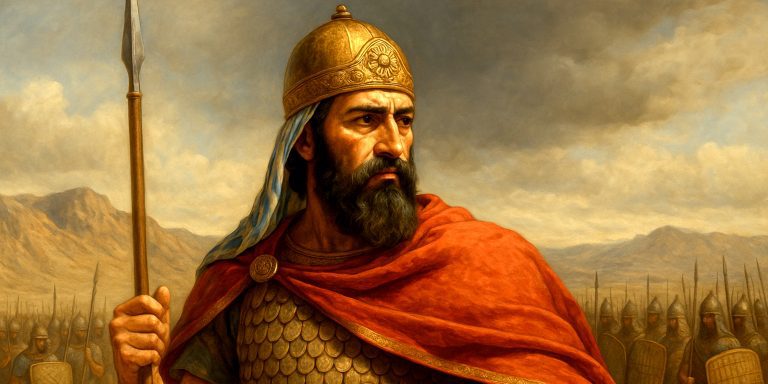
The two-handed macuahuitl sits at the centre of Mesoamerican warfare. It was a weapon that combined shock power with precision. Spanish accounts often described it with a mix of disbelief and respect, noting its ability to cut through shields and even injure armoured horses. The design looks unusual to modern eyes, yet it reflects a sophisticated approach to close combat where intimidation, control and cutting force all mattered.
This larger form of the macuahuitl was carried by elite warriors. It granted far greater reach and striking power than the standard one handed version. In the hands of a trained fighter it was both a symbol of status and a reliable battlefield tool.
Specification
A generalised specification based on surviving descriptions and archaeological findings.
Blade and Body
- Wooden core, usually from tough local hardwood
- Length between 90 cm and 120 cm for the body alone
- Total length could reach 150 cm or more
- Width commonly 6 cm to 8 cm
Cutting Edge
- Obsidian blades set along both edges
- Blades fixed with natural resins
- Sections shaped for rapid replacement
Grip
- Extended handle allowing two handed control
- Often wrapped in hide or cord for improved grip
Weight
- Approximately 3 kg
- Centre of balance favouring forward momentum
Specification Table
| Category | Details |
|---|---|
| Total Length | 140 to 160 cm |
| Core Material | Hardwood body with resin insets |
| Edge Material | Obsidian blades, replaceable |
| Estimated Weight | Around 3 kg |
| Grip | Two handed, hide or cord wrapped |
| Primary Use | Shock strikes, disabling blows, capture focused combat |
History and Evolution
The macuahuitl developed within the warfare traditions of the Aztec and their neighbours. Conflict across the region focused on capturing elite opponents, which shaped weapon design. Obsidian offered exceptional sharpness, although it lacked the durability of metal. The two handed version appeared as armies grew in size and combat roles became more specialised.
Spanish chroniclers recorded encounters with warriors using these longer weapons. Some described how a strike could remove a limb with a single blow. Although these accounts likely contain embellishment, they confirm how serious a threat the weapon posed. The two handed macuahuitl slowly vanished after the arrival of steel weapons in the sixteenth century but left a strong legacy in later indigenous accounts and illustrations.
Advantages and Disadvantages
Advantages
- Impressive cutting power due to leverage
- Long reach compared to the standard macuahuitl
- Highly intimidating profile
- Replaceable cutting blades
- Strong capture potential without killing instantly
Disadvantages
- Blades prone to shattering on hard armour
- Requires training for effective control
- Less durable than steel edged weapons
- Heavy compared to one handed versions
- Poor performance against plate or metal shields
Comparison with Similar Weapons
| Weapon | Strengths | Weaknesses |
|---|---|---|
| Two Handed Macuahuitl | Long reach, high cutting force, replaceable blades | Brittle edges, heavy, weaker against steel |
| One Handed Macuahuitl | Faster, lighter, easier to manoeuvre | Shorter reach, less strike power |
| European Two Handed Sword | Durable steel, powerful thrust and cut | Heavier training burden, not optimised for capture |
| Polynesian Kotiate or Gata | Excellent control and parrying | Short reach, limited cutting capacity |
Legacy
The macuahuitl became a defining symbol of Mesoamerican warfare. Even after its disappearance from the battlefield, it survived in codices, oral history and recreated examples in museums. Its mix of artistry and lethality makes it one of the most recognisable indigenous weapons of the Americas.
Modern experimental archaeology has added more insight. Tests using accurate reproductions confirm the weapon’s ability to deliver severe cutting trauma. They also reinforce the need for a skilled user, particularly when using the larger two handed design.
Where to See
Authentic two handed macuahuitl examples are extremely rare, although related single handed versions and reconstructions can be found in major institutions.
- Museo Nacional de Antropologia, Mexico City
- Museo del Templo Mayor, Mexico City
- The Weltmuseum, Vienna
- The Pitt Rivers Museum, Oxford
Collectors Guide
Surviving original examples rarely appear on the market. Most pieces available to collectors today are either nineteenth century displays or modern reproductions.
What Collectors Look For
- Accurate hardwood construction
- Authentic obsidian blade setting
- Provenance or link to historical collections
- Visual quality for display
Auction Prices
- Authentic examples, if a verified full two handed version surfaced, would likely command a price above 200,000 GBP
- High end nineteenth century display replicas typically range from 4,000 GBP to 12,000 GBP
- Quality modern reproductions usually fall between 400 GBP and 1,200 GBP depending on materials and accuracy
Care and Preservation
- Keep away from humidity which can weaken the resin
- Avoid touching obsidian directly since oils can damage the surface
- Display in stable lighting to prevent wood fading



